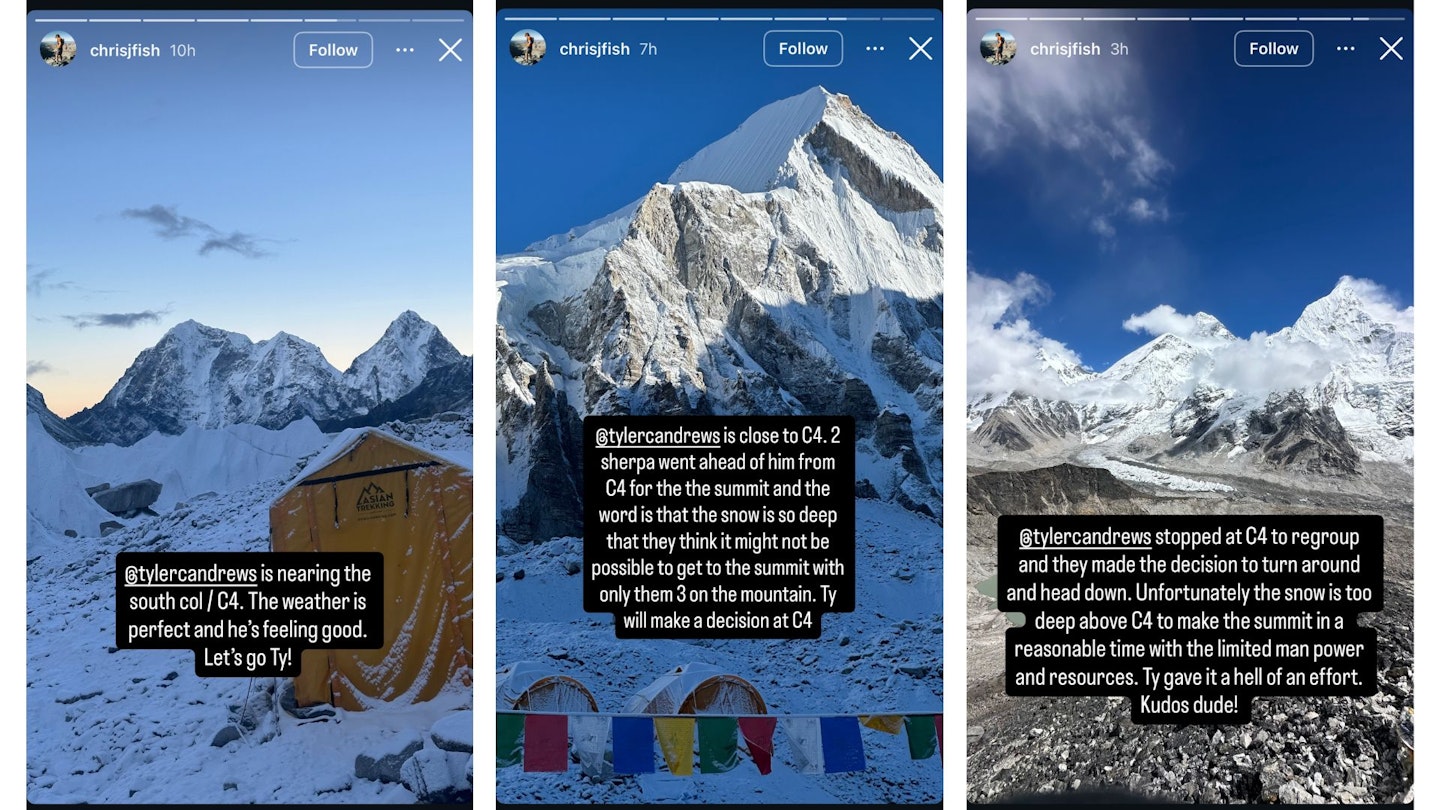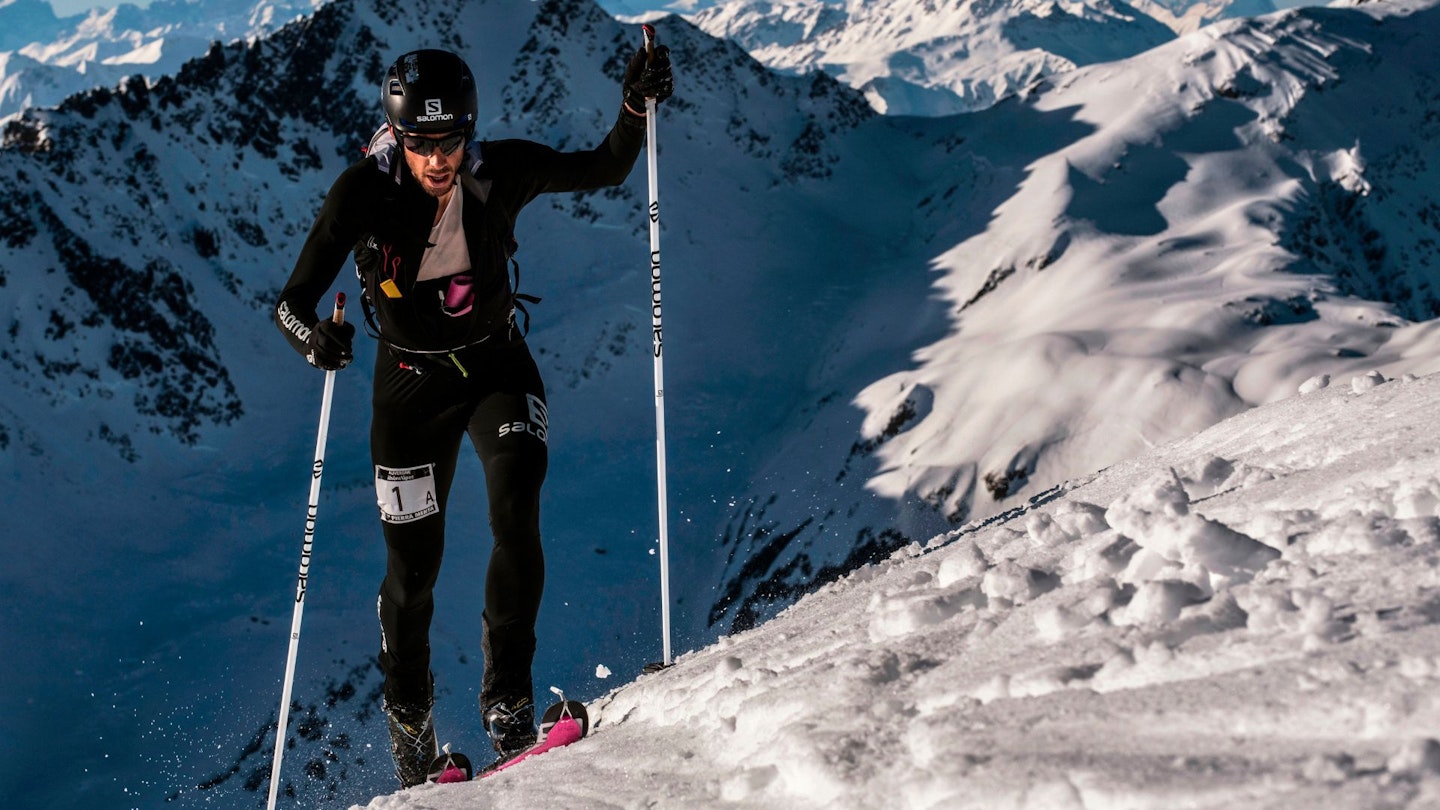For most climbers on Everest, a failed summit attempt is the end of their expedition, such is the toll that the effort has on their body. But that’s not been the case where Tyler Andrews is concerned.
The American ultra runner has made not one, but two attempts at setting the fastest known time (FKT) for an ascent of the world’s highest mountain from the south side this week.
Tyler made his first attempt of the autumn on Monday, making it up to 7,400m on Tuesday morning before turning around due to deep snow.
If at first you don't succeed...
But he was back on the move just three days later for the second attempt of the week, heading off from Everest Base Camp (EBC) at 8.20pm local time (which is 4hrs 45mins ahead of UK time).
By 11.08pm he’d made it through the dangerous Khumbu Icefall and was nearing Camp 1. Two hours later he’d been and left Camp 2 and was moving with pace toward the Lhotse Face (here's our guide to Everest's biggest features).
He reached 7,661m by 7.15am and reached the South Col just after 9am, which is where most climbing expeditions start their summit night from.
But then things went silent. There were no updates from Tyler’s team for over six hours and, despite a note to say that radio and satellite updates are less reliable at this elevation, the lack of info became unnerving.

An update from Chris Fisher, who’s on the as part of Tyler’s team on the mountain, then shed some light on the situation: “Tyler is close to C4. Two Sherpa went ahead of him from C4 for the summit and the word is that the snow is so deep that they think it might not be possible to get to the summit with only three of them on the mountain.”
Then, a few hours later another update followed: “Tyler stopped at C4 to regroup and they made the decision to turn around and head down.
“Unfortunately the snow is too deep above C4 to make the summit in a reasonable time with the limited man power and resources. Ty gave it a hell of an effort.”
What record was Tyler actually trying to break?
Such is the nature of mountain records that you inevitably end up with multiple records that sound quite similar, so it takes a bit of time to understand which one is actually being targeted.
In this case, Tyler was aiming for Kazi Sherpa’s summit time of 20hrs, 24mins. This particular record would need to be set without supplementary oxygen and follow the south route.
This takes climbers from base camp, through the Khumbu Icefall, up the Lhotse Face to the South Col, and then over the Hillary Step and South Summit on the way to the true summit at 8,849m.
Tyler’s goal was to climb solo, though for this particular record he was able to use fixed lines.
What’s the quickest anyone has ever climbed Everest?

Now, people have climbed Everest in less time than that. Lhakpa Gelu Sherpa reached the summit via the South Col in a staggering 10hrs 56mins 46secs using supplementary oxygen in 2003. That’s the record you’ll currently find recognised by Guinness World Records.
Looking at the north side of Everest, the fastest ascent without supplemental oxygen or support belongs to Hans Kammerlander, who climbed from Advanced Base Camp (ABC) to the summit in 16hrs 43mins.
World-famous mountain runner Kilian Jornet had his own crack at an Everest record in 2017. The Spaniard first attempted to summit starting from Rongbuk Monastery, which sits at an altitude of 5,100m, while most record attempts start from ABC at 6,400m.
Despite bouts of diarrhoea and vomiting, Kilian managed to reach the summit in 26hrs, having used no support, supplemental oxygen or fixed ropes along the way.
Seemingly displeased with that, he then set off from ABC five days later to have another crack at the record, claiming to have summited in 17hrs – 15mins behind the record that Hans set in 1996.
Fifth time’s the charm?
The second summit push of this week was Tyler's fifth attempt at the record. Three of those came in the spring, while the fourth began at the start of this week and came to an end just three days before on Tuesday 23 September.
While Tyler made good time after setting out at the start of the week he had a setback after falling into a crevasse in the Khumbu Icefall. Undeterred, after digging himself out of that situation he continued up the mountain, but was soon concerned by potentially unstable wind slab on the Lhotse Face.
After some more progress he called the attempt off, with the snow getting worse and proving hard to break through solo.
When announcing his plans to make another attempt this autumn, Tyler himself outlined some of the added difficulties. While you don't have the crowds and queues that you get in spring, autumn does typically bring more snow following the summer monsoon season, which can lead to increased avalance risk.
The snow can also fill crevasses and create more direct routes through the Khumbu Icefall, but even that brings its own inherent risks. There are also normally fewer stable weather windows in autumn.
Almost in touching distance
The closest he came to reaching the summit was during his third attempt in spring. This came just three days after a previous failed attempt (with oxygen from Camp 2), where high winds proved decisive and saw him turn around just after Camp 4.
But on the third attempt he got within 400m of the summit. He left Camp 4 convinced that he was going to beat the record, but soon came unstuck.
“I had one of my gels and vomited it immediately, which is something that had never happened to me before. Maybe it was the altitude or exhaustion, but probably I should have returned to camp and tried to eat something else,” he told Explorers Web.
Tyler continued, but was unable to take on and keep down any more nutrition. Then, after making it past the Balcony, he started having hallucinations. At this point, standing at an elevation of 8,450m, he made the decision to turn back.
Who is Tyler Andrews?
Tyler Andrews is a pro runner and mountaineer that has dozens of accolades to his name. As a runner, he's won multiple ultras and set new records along the way, including course records and the fastest time for a 50km track run (achieved in 2018 with a time with 2hrs 46mins 6secs).
He has a numerous fastest known times (FKTs) to his name, including speed records on:
Aconcagua: 4hrs 35mins 20secs for a round trip from Plaza del Mulas
Kilimanjaro: 4hrs 32mins 40secs to the summit
Ama Dablam: 3hrs 52mins 23secs to the summit
Mount Manaslu: 14hrs 52mins 14secs for a round trip from base camp
